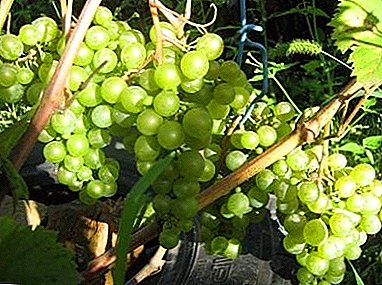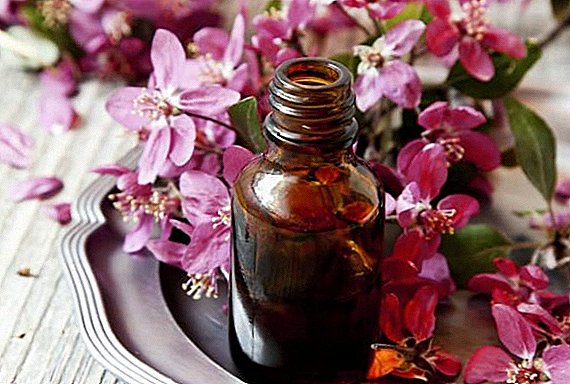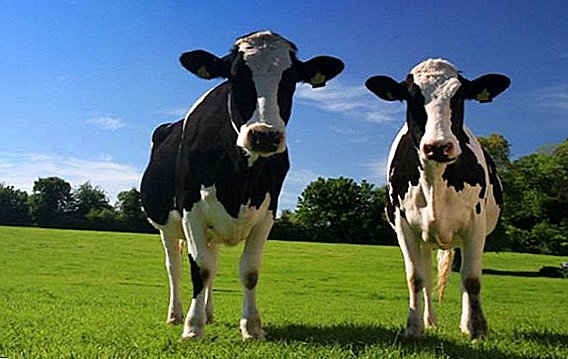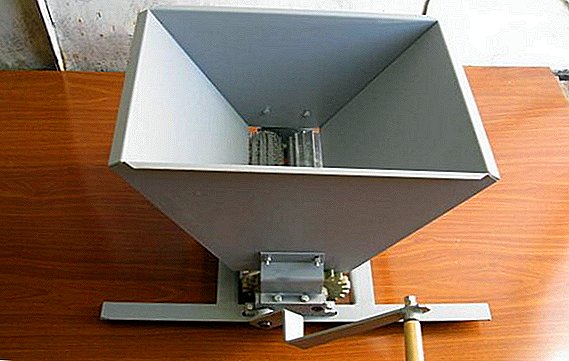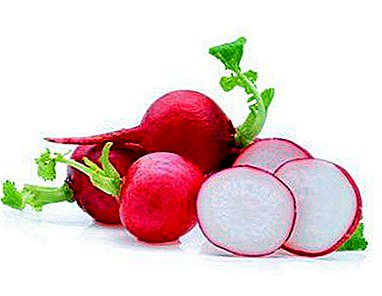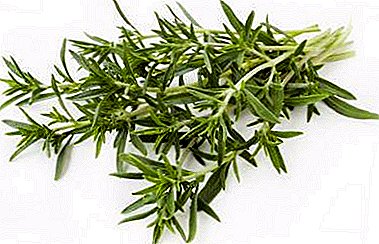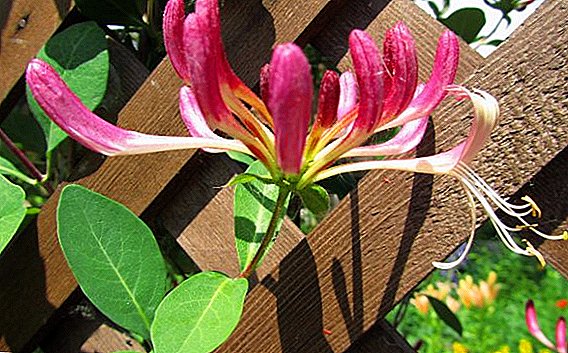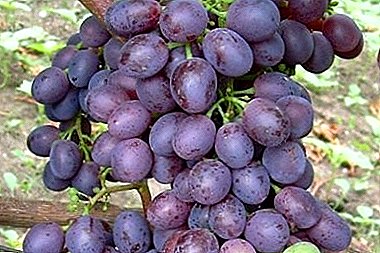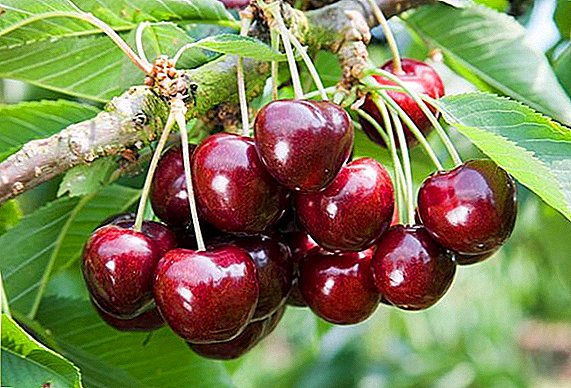 Sweet Cherry "Ovstuzhenka" is quite a popular variety.
Sweet Cherry "Ovstuzhenka" is quite a popular variety.
Its description does not leave indifferent, as the tree has a good yield, good tolerance of cold weather and excellent taste.
Breeding history
“Ovtuzhenka” is a relatively early variety of sweet cherry, which has the fruits of an average ripening period. This sort of sweet cherry was synthesized at the All-Russian Scientific Research Institute of Lupine by mixing two varieties - Leningradskaya Chernya and Compact Venyaminova. The authorship of this hybrid belongs to M. Kanshina.  In the early 2000s, the Ovstuzhenka variety was introduced into the State Register of Breeding Achievements. It should be noted that it has best established itself in the south of the Black Earth.
In the early 2000s, the Ovstuzhenka variety was introduced into the State Register of Breeding Achievements. It should be noted that it has best established itself in the south of the Black Earth.
Description and characteristics of the variety
"Ovstuzhenka" very often planted in private gardens, as it has no special requirements for care and already in the early summer gives a good result. Describing a variety, it is necessary to dwell on several aspects: consideration of the tree, fruit and yield.
Tree description
Cherry varieties "Ovstuzhenka" differ in modest dimensions, small height and good growth rate. The crown of the tree does not have a large amount of foliage, spherical and slightly raised. Sweet cherry shoots have a small thickness, differ in a brown-brown shade.  The buds of the cherries are large and pointed. Vegetative buds have a conical shape, generative - egg-shaped. The leaves, too, are egg-shaped and large; they are distinguished by a round base and a strongly pointed tip. The color is classic green, and the young leaves are highly pigmented. The foliage is rather flat and matte. Petioles small, short.
The buds of the cherries are large and pointed. Vegetative buds have a conical shape, generative - egg-shaped. The leaves, too, are egg-shaped and large; they are distinguished by a round base and a strongly pointed tip. The color is classic green, and the young leaves are highly pigmented. The foliage is rather flat and matte. Petioles small, short.
The inflorescences are three-flowered. The flowers are quite large, and the petals are embedded in each other. At the height of the stamens is the stigma of the pistil. The sepals are pigmented and not serrated, and the cup itself has a goblet shape. Fruit ovaries are located directly on the bouquet branches.
Familiarize yourself with the cultivation of the cultivation of Regina, Bull's Heart, Revna, Bryansk Pink, Krupnoplodnaya, Valeriy Chkalov, Daybera Chernaya cultivars.
Fruit Description
Fruits of "Ovstuzhenka" sweet cherry are round, possess a peaked top. On average, the berry weighs up to 7 g, and the width and height of one fruit is up to 20 mm. The thin and dense skin has a maroon color. The flesh of the fruit is very sweet and juicy. 
Did you know? Cherry is the most ancient form of cherry, about which mankind learned 10,000 years ago.Cherry fruits on the bouquet branches. Very beautiful and lush berries do not cheat, because they have excellent taste.
Yield
Sweet Cherry "Ovstuzhenka" is a high-yielding tree. Nevertheless, the average productivity of early trees is 15 kg per tree, which is not a high indicator of yield. This does not apply to mature trees, since the maximum weight of fruits per one fully grown tree reaches 32 kg.
The first fruits ripen in early June. On average, wood yields can range from 20 to 26 kg. 
Important! Sweet cherry is subject to manual collection. In order for the shelf life of the berry to be longer, it is necessary to cut it off together with the stem.During the week, the berry can maintain full freshness, the temperature should stay at the level of + 3-6 ° C, and the humidity of the air - 80-90%. Berry has good transportability. In the event that long-term storage of berries is required, it is subjected to freezing.
"Ovstuzhenka" is a universal variety of sweet cherries. This is due to the suitability of berries both for fresh consumption and for further processing. Very often it is used as a basis for compote, jelly or jam, juice and pastry sweets.
How to choose seedlings when buying
It is important to note that all planting material must be purchased in garden stores, as there are a large number of fakes on the market that are very difficult to distinguish from originals. In order to choose a quality sapling, you need to pay attention to the presence of such characteristics:
- clearly allocated vaccination site;
- sapling has a large number of branches;
- there are no wrinkles and spots on the bark;
- dried roots on the root system are absent.
How to choose a place
Despite the fact that the variety “Ovtuzhenka” is not the most fastidious, it is necessary to choose the right place where the future garden or a single sweet cherry will flourish. In choosing a place, the main components are the soil and the amount of lighting.
Lighting
As such, there are no categorically necessary requirements for planting Ovstusenka saplings. Nevertheless, it is recommended to plant trees on the south side of the garden so that the sunlight has free access to the cherry trees. If the sun does not warm the tree and the ground under it, growth and development can slow down significantly. 
The soil
Plots of land that have good breathability and light soil are considered the most suitable. Even sandy or loamy surfaces can be excellent.
An important aspect when choosing a soil is the groundwater approach, which should not exceed one and a half meters. If there is no such place, then it is necessary to dig a drainage ditch.
Preparatory work before landing
Proper preparation of the soil and seedlings is the key to a good harvest.
Site preparation
The most important aspect of preparing land for planting is the preparation of pits for planting. This is due to the fact that the “Ovstuzhenka” sweet cherry is one of the most demanding on the nutrient content of the soil. In the event that the planting is made on clay soil, you need to lay several buckets of sand on the bottom of the pit.  During spring preparation planting pits required "ennoble" two weeks before planting seedlings. The pit should be filled with nutrient by one third: 2 buckets of soil, up to 3 kg of superphosphate, 1 kg of potash mixtures and 1 kg of ash, up to 30 kg of humus or compost. When using such equipment there is no need to use nitrogen fertilizers, as they can burn the roots of the tree.
During spring preparation planting pits required "ennoble" two weeks before planting seedlings. The pit should be filled with nutrient by one third: 2 buckets of soil, up to 3 kg of superphosphate, 1 kg of potash mixtures and 1 kg of ash, up to 30 kg of humus or compost. When using such equipment there is no need to use nitrogen fertilizers, as they can burn the roots of the tree.
Did you know? Sweet cherry, the stem of which is yellow or orange in color, is the best abode for worms.In the period of autumn preparation landmark goes to the next spring. Initially, you need to dig a hole, the diameter and depth of which will be about one meter. The earth should be mixed with several buckets of humus, add up to 100 g of potassium, up to 300 g of superphosphate. 500 g of wood ash can be used as a good fertilizer. The entire soil mixture should be at the bottom of the pit and be covered with earth free from impurities.
It should be noted that the entire area of the future cherry orchard is worth plowing. When the garden is dug up, it is necessary to use organic and mineral nutrients.  One square meter needs 10 kg of compost, 200 g of superphosphate, 150 g of potash. In the event that there is a complex fertilizer, 250 g of top dressing should be used per square meter of land.
One square meter needs 10 kg of compost, 200 g of superphosphate, 150 g of potash. In the event that there is a complex fertilizer, 250 g of top dressing should be used per square meter of land.
Seedling preparation
The sapling does not require special preparation, since the main work is done directly with the soil for the future of the tree. Nevertheless, it is recommended to keep the seedling in its pure form, so that it can "breathe" freely and absorb the nutrients that are located in the pit. It is also not necessary to keep the sapling in the sun before planting, as it may dry out and will not give proper yield in the future.
Immediately before planting, it is necessary to clear the sapling from green leaves. The root can be dipped into the clay mixture and kept there for several hours: this will strengthen it and increase its nutritional capacity.
Step by step landing instructions
Planting seedlings "Ovstuzhenka" can be made in spring and autumn. In the middle - the end of April, when the earth managed to warm up after a long winter, you can begin the preparatory work and plant the seedlings. In autumn, land should be planted in mid-October, when the earth is still warm, but not dried out by the summer heat. Adhering to a certain straightforward route you can achieve good results:
- First you need to dig in the landing pit recess, the diameter of which will reach 1 meter.
- Through a wooden peg that is inserted into the recess, an earthen mound is formed.
- The seedling must be lowered into the pit, while the root collar should be visible 7-8 cm above the ground.
- Next, straighten the roots directly on the bottom and evenly sprinkled with earth.
- For future sustainability, near-bore ground must be compacted.
- From the ground it is necessary to make a hole with a rim, the diameter of which will be 50 cm.
- On the seedling you need to spend about 20 liters of water.
- Pristvolny circle should be thrashed with straw or peat.
Important! If you are planting a garden, the distance between the trees should be about 5 m.
Seasonal care features
In order for the tree to grow and develop successfully, to provide a consistently high yield, it is necessary to carry out regular works on the care of cherries. Conditionally, care can be called seasonal, since the main work is carried out in spring, summer and autumn. However, additional work must be done regularly. 
Soil care
It should be noted that the sweet cherry is a water-loving tree, as a result of which it prefers moist soil. In order for the tree to grow and develop productively, it is necessary to produce up to three waterings in one season:
- before the beginning of flower development - in the middle of May;
- in the period of filling the fruit - in early July;
- pre-winter watering - after the harvest, before the onset of cold weather.
The near-stem should remain clean and the roots should breathe. Loosening the soil will help maintain air circulation. By loosening, it is necessary to destroy the soil crust and remove weed sprouts. Land strata should not be turned over.  Heavy soils can be mulched after the earth has fully warmed to the sun. If you do this earlier, the mulch will keep the cold underground, which will adversely affect the development of the tree. Mulching should be done immediately after draining water or drying out the soil, when it will crumble when hit with a shovel. As a mulching material, dried grass, straw, sawdust, crushed corn stalks, and peat are perfect.
Heavy soils can be mulched after the earth has fully warmed to the sun. If you do this earlier, the mulch will keep the cold underground, which will adversely affect the development of the tree. Mulching should be done immediately after draining water or drying out the soil, when it will crumble when hit with a shovel. As a mulching material, dried grass, straw, sawdust, crushed corn stalks, and peat are perfect.
Regular weeding of pristvolny circles will allow to remove small weeds. Chemical weeding is not recommended, as it can harm both the tree and the soil.
Top dressing
Sweet cherry is not a very picky tree, therefore, it does not need excessive care and care. “Ovtuzhenka” in this aspect, in contrast to the landing, is no different from its relatives. In the autumn and spring, it will be enough to add nutrients by the root method.  In the autumn (early September) follows use slurry, previously diluted with water in a ratio of 1: 8, different whole granules of fertility (use 100 g of nutrients for one bucket of water). If humus is available, then you can pack 20 kg under one tree.
In the autumn (early September) follows use slurry, previously diluted with water in a ratio of 1: 8, different whole granules of fertility (use 100 g of nutrients for one bucket of water). If humus is available, then you can pack 20 kg under one tree.
In the spring (end of April) follows to dig and loosen the land. It is during this period that 50 g of superphosphate and the same amount of carbamide per square meter should be added evenly.
Important! Every three to four years it is necessary to make the liming of the earth. It is necessary to produce watering near-wellbore site with the essence of ash. Per square meter consume 2 kg of wood ash per bucket of water.
Preventive treatment
In order to protect the cherries from the effects of diseases and "ill-wishers", it is necessary to carry out preventive treatment. This is done in the spring, before the beginning of the sap flow, and in the fall, when massive leaf fall occurs. In order to properly process the sweet cherry, it is necessary to dissolve up to 700 g of urea in 10 liters of water. Next, you need to spray the trees for the destruction of pathogens and insect pests. 
Did you know? Sweet cherry is the basis for the production of food coloring. When using ripe cherries, the color of the dye is green.It is important to check before processing sweet cherries whether sap flow has occurred. This is due to the fact that the solution can burn drop buds. To control nomadic pests, it is necessary to treat the cherries with "Akarin", "Fitoverm", "Agravertin".
During the period of prophylactic treatment, it is necessary to spray the cherry with "Zircon", which will significantly increase the resistance of the tree to the cold.
Cropping and crown formation
Pruning cherries produce twice a year: in November, when the foliage falls, and in April, before the budding begins. Spring pruning helps in the development of the crown and the eradication of large unwanted branches. It is necessary to remove the branches and shoots that grow up and thicken the crown. Autumn pruning is considered sanitary, as it is directly related to the removal of damaged and dead branches.  As a rule, all branches that develop at a slight angle (up to 45 degrees) should be removed. All large branches must be cut to the ring so that there is no hemp left.
As a rule, all branches that develop at a slight angle (up to 45 degrees) should be removed. All large branches must be cut to the ring so that there is no hemp left.
Important! All cuts that have a diameter of 1.5 cm, must be processed garden pitch.
Protection against cold and rodents
Cherry "Ovstuzhenka" has excellent resistance to such dangerous diseases as coccomycosis and moniliosis. The main danger to the tree are cold winds and rodents.
Adult sweet cherries do not require shelter, as they tolerate the winter well under the conditions of mulching of the near-stem space with peat, whitewashing the trunk and the base of the skeletal branches.  In the case of young cherries, it is necessary in the cold seasons to tie them with spruce branches and wrap with sacking, which will keep warm. Do not use artificial materials, as the plants die due to lack of air circulation.
In the case of young cherries, it is necessary in the cold seasons to tie them with spruce branches and wrap with sacking, which will keep warm. Do not use artificial materials, as the plants die due to lack of air circulation.
To fight rodents, it is best to use special nets that are wound over a tree.
Sweet Cherry "Ovstuzhenka" is a universal variety that has excellent taste, high yield, stability and excellent resistance to diseases. The biggest advantage of this variety is that it is completely independent of pollinating insects, as it is a self-bearing plant.


